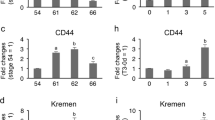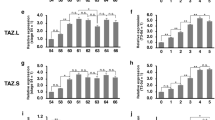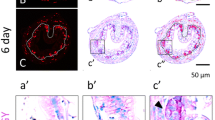Abstract
A Xenopus laevis homolog of nucleophosmin/nucleoplasmin3 (NPM3), no29, has been previously identified as a thyroid hormone (TH)-response gene during TH-induced metamorphosis. X. laevis has another NPM3 homolog (npm3) in the pseudo-tetraploid genome, whereas X. tropicalis possesses one ortholog in the diploid genome. To assess the possible roles of these NPM3 homologs in amphibian metamorphosis, we have analyzed their expression profiles in X. laevis tadpoles. Levels of no29 and npm3 mRNA are rapidly up-regulated by exogenous TH in various organs of the premetamorphic tadpoles. Notably, in the small intestine, no29 and npm3 mRNA levels are transiently up-regulated during metamorphic climax, when progenitor/stem cells of the adult epithelium appear and actively proliferate. In situ hybridization analysis has revealed that the no29 transcript is specifically localized in adult epithelial progenitor/stem cells of the intestine during natural and TH-induced metamorphosis. Double-staining for in situ hybridization and immunohistochemistry has shown co-expression of no29 mRNA and no38 protein (an ortholog of NPM1), which is known to interact with NPM3 and to regulate cell proliferation in mammals. Thus, no29/npm3 might serve as a stem cell marker in the intestine during metamorphosis.





Similar content being viewed by others
References
Ahn J, Liu X, Cheng D, Peng J, Chan P, Wade P, Ye K (2005) Nucleophosmin/B23, a nuclear PI(3,4,5)P(3) receptor, mediates the antiapoptotic actions of NGF by inhibiting CAD. Mol Cell 18:435–445
Barker N, Es JH van, Kuipers J, Kujala P, Born M van den, Cozijnsen M, Haegebarth A, Korving J, Begthel H, Peters PJ, Clevers H (2007) Identification of stem cells in small intestine and colon by marker gene Lgr5. Nature 449:1003–1007
Brown D, Cai L (2007) Amphibian metamorphosis. Dev Biol 306:20–33
Buchholz D, Heimeier R, Das B, Washington T, Shi Y-B (2007) Pairing morphology with gene expression in thyroid hormone-induced intestinal remodeling and identification of a core set of TH-induced genes across tadpole tissues. Dev Biol 303:576–590
Cheng H, Bjerknes M (1985) Whole population cell kinetics and postnatal development of the mouse intestinal epithelium. Anat Rec 211:420–426
Colombo E, Marine J, Danovi D, Falini B, Pelicci P (2002) Nucleophosmin regulates the stability and transcriptional activity of p53. Nat Cell Biol 4:529–533
Das B, Cai L, Carter M, Piao Y, Sharov A, Ko M, Brown D (2006) Gene expression changes at metamorphosis induced by thyroid hormone in Xenopus laevis tadpoles. Dev Biol 291:342–355
Dodd MHI, Dodd JM (1976) The biology of metamorphosis. In: Lofts B (ed) Physiology of Amphibia. Academic Press, New York, pp 444–599
Eirín-López J, Frehlick L, Ausió J (2006) Long-term evolution and functional diversification in the members of the nucleophosmin/nucleoplasmin family of nuclear chaperones. Genetics 173:1835–1850
Grisendi S, Bernardi R, Rossi M, Cheng K, Khandker L, Manova K, Pandolfi P (2005) Role of nucleophosmin in embryonic development and tumorigenesis. Nature 437:147–153
Hasebe T, Hartman R, Matsuda H, Shi Y-B (2006) Spatial and temporal expression profiles suggest the involvement of gelatinase A and membrane type 1 matrix metalloproteinase in amphibian metamorphosis. Cell Tissue Res 324:105–116
Hasebe T, Kajita M, Fujimoto K, Yaoita Y, Ishizuya-Oka A (2007) Expression profiles of the duplicated matrix metalloproteinase-9 genes suggest their different roles in apoptosis of larval intestinal epithelial cells during Xenopus laevis metamorphosis. Dev Dyn 236:2338–2345
Hasebe T, Kajita M, Shi Y-B, Ishizuya-Oka A (2008) Thyroid hormone-up-regulated hedgehog interacting protein is involved in larval-to-adult intestinal remodeling by regulating sonic hedgehog signaling pathway in Xenopus laevis. Dev Dyn 237:3006–3015
Hasebe T, Buchholz DR, Shi Y-B, Ishizuya-Oka A (2011) Epithelial-connective tissue interactions induced by thyroid hormone receptor are essential for adult stem-cell development in the Xenopus laevis intestine. Stem Cells 29:154–161
Heimeier R, Das B, Buchholz D, Fiorentino M, Shi Y-B (2010) Studies on Xenopus laevis intestine reveal biological pathways underlying vertebrate gut adaptation from embryo to adult. Genome Biol 11:R55
Hourdry J, Dauca M (1977) Cytological and cytochemical changes in the intestinal epithelium during anuran metamorphosis. Int Rev Cytol Suppl 5:337–385
Huang N, Negi S, Szebeni A, Olson M (2005) Protein NPM3 interacts with the multifunctional nucleolar protein B23/nucleophosmin and inhibits ribosome biogenesis. J Biol Chem 280:5496–5502
Ishizuya-Oka A, Shi Y-B (2007) Regulation of adult intestinal epithelial stem cell development by thyroid hormone during Xenopus laevis metamorphosis. Dev Dyn 236:3358–3368
Ishizuya-Oka A, Shi Y-B (2008) Thyroid hormone regulation of stem cell development during intestinal remodeling. Mol Cell Endocrinol 288:71–78
Ishizuya-Oka A, Ueda S (1996) Apoptosis and cell proliferation in the Xenopus small intestine during metamorphosis. Cell Tissue Res 286:467–476
Ishizuya-Oka A, Ueda S, Inokuchi T, Amano T, Damjanovski S, Stolow M, Shi Y-B (2001) Thyroid hormone-induced expression of sonic hedgehog correlates with adult epithelial development during remodeling of the Xenopus stomach and intestine. Differentiation 69:27–37
Ishizuya-Oka A, Shimizu K, Sakakibara S, Okano H, Ueda S (2003) Thyroid hormone-upregulated expression of Musashi-1 is specific for progenitor cells of the adult epithelium during amphibian gastrointestinal remodeling. J Cell Sci 116:3157–3164
Ishizuya-Oka A, Hasebe T, Buchholz D, Kajita M, Fu L, Shi Y-B (2009) Origin of the adult intestinal stem cells induced by thyroid hormone in Xenopus laevis. FASEB J 23:2568–2575
Itahana K, Bhat K, Jin A, Itahana Y, Hawke D, Kobayashi R, Zhang Y (2003) Tumor suppressor ARF degrades B23, a nucleolar protein involved in ribosome biogenesis and cell proliferation. Mol Cell 12:1151–1164
Kordylewski L (1983) Light and electron microscopic observations of the development of intestinal musculature in Xenopus. Z Mikrosk Anat Forsch 97:719–734
Madara JL, Trier JS (1994) Functional morphology of the mucosa of the small intestine. In: Johnson LR (ed) Physiology of the gastrointestinal tract. Raven, New York, pp 1577–1622
Marshall JA, Dixon KE (1978) Cell specialization in the epithelium of the small intestine of feeding Xenopus laevis tadpoles. J Anat 126:133–144
Matsuda H, Shi Y-B (2010) An essential and evolutionarily conserved role of protein arginine methyltransferase 1 for adult intestinal stem cells during postembryonic development. Stem Cells 28:2073–2083
McAvoy JW, Dixon KE (1977) Cell proliferation and renewal in the small intestinal epithelium of metamorphosing and adult Xenopus laevis. J Exp Zool 202:129–138
Motoi N, Suzuki K, Hirota R, Johnson P, Oofusa K, Kikuchi Y, Yoshizato K (2008) Identification and characterization of nucleoplasmin 3 as a histone-binding protein in embryonic stem cells. Dev Growth Differ 50:307–320
Nieuwkoop PD, Faber J (1956) Normal table of Xenopus laevis (Daudin). Elsevier North-Holland Biomedical Press, Amsterdam
Okuda M, Horn H, Tarapore P, Tokuyama Y, Smulian A, Chan P, Knudsen E, Hofmann I, Snyder J, Bove K, Fukasawa K (2000) Nucleophosmin/B23 is a target of CDK2/cyclin E in centrosome duplication. Cell 103:127–140
Okuwaki M (2008) The structure and functions of NPM1/Nucleophosmin/B23, a multifunctional nucleolar acidic protein. J Biochem 143:441–448
Potten CS, Booth C, Tudor GL, Booth D, Brady G, Hurley P, Ashton G, Clarke R, Sakakibara S, Okano H (2003) Identification of a putative intestinal stem cell and early lineage marker; musashi-1. Differentiation 71:28–41
Ramalho-Santos M, Melton DA, McMahon AP (2000) Hedgehog signals regulate multiple aspects of gastrointestinal development. Development 127:2763–2772
Savkur R, Olson M (1998) Preferential cleavage in pre-ribosomal RNA by protein B23 endoribonuclease. Nucleic Acids Res 26:4508–4515
Schmidt-Zachmann M, Hügle-Dörr B, Franke W (1987) A constitutive nucleolar protein identified as a member of the nucleoplasmin family. EMBO J 6:1881–1890
Shackleford G, Ganguly A, MacArthur C (2001) Cloning, expression and nuclear localization of human NPM3, a member of the nucleophosmin/nucleoplasmin family of nuclear chaperones. BMC Genomics 2:8
Shi Y-B (1999) Amphibian metamorphosis: from morphology to molecular biology. Wiley, New York
Shi Y-B, Ishizuya-Oka A (1996) Biphasic intestinal development in amphibians: embryogenesis and remodeling during metamorphosis. Curr Top Dev Biol 32:205–235
Shi Y-B, Ishizuya-Oka A (2001) Thyroid hormone regulation of apoptotic tissue remodeling: implications from molecular analysis of amphibian metamorphosis. Prog Nucleic Acid Res Mol Biol 65:53–100
Shi Y-B, Liang V (1994) Cloning and characterization of the ribosomal protein L8 gene from Xenopus laevis. Biochim Biophys Acta 1217:227–228
Sun G, Hasebe T, Fujimoto K, Lu R, Fu L, Matsuda H, Kajita M, Ishizuya-Oka A, Shi Y-B (2010) Spatio-temporal expression profile of stem cell-associated gene LGR5 in the intestine during thyroid hormone-dependent metamorphosis in Xenopus laevis. PLoS ONE 5:e13605
Suzuki K, Machiyama F, Nishino S, Watanabe Y, Kashiwagi K, Kashiwagi A, Yoshizato K (2009) Molecular features of thyroid hormone-regulated skin remodeling in Xenopus laevis during metamorphosis. Dev Growth Differ 51:411–427
Suzuki K, Kashiwagi K, Ujihara M, Marukane T, Tazaki A, Watanabe K, Mizuno N, Ueda Y, Kondoh H, Kashiwagi A, Mochii M (2010) Characterization of a novel type I keratin gene and generation of transgenic lines with fluorescent reporter genes driven by its promoter/enhancer in Xenopus laevis. Dev Dyn 239:3172–3181
Swaminathan V, Kishore A, Febitha K, Kundu T (2005) Human histone chaperone nucleophosmin enhances acetylation-dependent chromatin transcription. Mol Cell Biol 25:7534–7545
Turner DL, Weintraub H (1994) Expression of achaete-scute homolog 3 in Xenopus embryos converts ectodermal cells to a neural fate. Genes Dev 15:1434–1447
Veldhoen N, Crump D, Werry K, Helbing C (2002) Distinctive gene profiles occur at key points during natural metamorphosis in the Xenopus laevis tadpole tail. Dev Dyn 225:457–468
Zirwes R, Schmidt-Zachmann M, Franke W (1997) Identification of a small, very acidic constitutive nucleolar protein (NO29) as a member of the nucleoplasmin family. Proc Natl Acad Sci USA 94:11387–11392
Acknowledgements
We thank Mrs. Mitsuko Kajita (Nippon Medical School) for her technical help. Part of this research was performed when K.S. and N.M. were affiliated to the Graduate School of Science, Hiroshima University, Japan.
Author information
Authors and Affiliations
Corresponding author
Additional information
Natsuki Motoi and Takashi Hasebe contributed equally to this work.
This study was supported by a Grant-in-Aid for Scientific Research from the Japan Society for the Promotion of Science (JSPS) to K.S. and A.I.-O., a Narishige Zoological Science Award to T.H., and a grant from the Naito Foundation to K.S. Additional support by the “Global COE Program” of the Ministry of Education, Culture, Sports, Science, and Technology (MEXT), Japan is gratefully acknowledged by K.S.
Rights and permissions
About this article
Cite this article
Motoi, N., Hasebe, T., Suzuki, Ki.T. et al. Spatiotemporal expression profile of no29/nucleophosmin3 in the intestine of Xenopus laevis during metamorphosis. Cell Tissue Res 344, 445–453 (2011). https://doi.org/10.1007/s00441-011-1163-0
Received:
Accepted:
Published:
Issue Date:
DOI: https://doi.org/10.1007/s00441-011-1163-0




